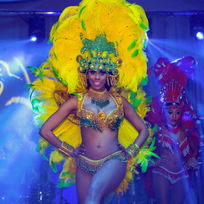
A Beginner's Guide To Latin American Music
Think Latin American music - Think Salsa? Think further! This article takes us through a beginner's guide to Latin American music. To see our list of Latin & Salsa bands for hire, go here, for a complete booking guide, go here, for ideas and inspiration for your Brazilian Themed Party, go here and should you wish to learn some Salsa dance moves, go here.
At face value, Latin American styles of music may constitute a combination of African rhythms and European harmony. In reality, these combinations vary hugely from one Latin American culture to the next; depending on myriads of factors - economical, geographical, historical, political, social - the list is endless. For example, in the case of many Brazilian styles of music, there is a third major influence, that of the indigenous Indian cultures in South America. These different styles of music - like any other popular art music forms - have developed through time, so, with them, you get that temporal, as well as spatial, variation; traditional versus contemporary.
Latin-American Styles Developing Through Place
Thus, the timba-reggaeton that is happening in Cuba today is very different from the traditional music that was happening in sixteenth century West Africa, before the advent of colonialism. Latin American styles of music have not only developed through time, but they have developed through place; through upheavals attributed to those factors listed above. You can almost draw a map with lines, dates and progression routes drawn from one place to the next.
The Latin Influence
Yet this does not mean that there is no interaction between the timba-reggaeton in Cuba and the traditional music in West Africa, as 'opposite ends of the same scale', for they are mutually influential, the one informing the other. Contemporary salsa artists such as Marc Anthony or Paulo FG and Cuban Jazz artists such as Maraca or Klimax still look to the influence of African religious rituals as the foundations of their music. At the same time, artists originating from Africa and working internationally - Angelique Kidjo, Baaba Maal, Papa Wemba, Salif Keita - recognise the Latin influence in music as products of their own music, and cross-appropriate these in many songs.
Examples of Latin artists
Sonido Latino
3 Latin, Salsa & World Music London
With flair for performing, Sonido Latino is one of the most sought after & lively Salsa bands on the London scene today. Its flexible 4 to 8 piece line-up is perfect for background or upbeat party music, playing songs like Guantaramera and La Bamba.Price from £1,225Mamba Rumba
51 Latin, Salsa & World Music East Yorkshire
Mamba Rumba are versatile enough to suit any event with their accessible, rhythmic and upbeat styles - a repertoire to suit across age ranges and tastes - whilst also able to specialise in Cuban, Latin and Brazilian styles and jazzy sounds.Price from £479Latamba Show Band
50 Latin, Salsa & World Music London
Latamba are a London based, Multi-Award winning Brazilian Show Band available in different format and line-ups. A visually eye-catching show presentation!Price from £2,663
The Cross-Appropriation of Latin American Music Styles
In this way, Latin American styles of music are characterised by cross-appropriation at all levels - between Africa and the Caribbean, between the Caribbean and North and South America, between North and South America and Africa - and visa versa on all accounts. These appropriations are further facilitated - like any other popular or world music movements - not only through increasing trade and tourism networks, but also through migration, multimedia and the World Wide Web, such that these lines, dates and progression routes become transparent and meaningless.
The Latin American Music Pyramid
Hence, our concept of Latin American music is no longer a 'map' of lines, dates and progression routes. You begin to think of it more as a pyramid. One pathway diverges, the original pathway carries on underneath and the offset goes in a completely different direction. This new pathway, in turn, becomes the original pathway for a new diversion. Multiply this pattern a potentially infinite number of times. Then imagine your pyramid as a kind of ontological entity of music genres, united by similar characteristics. When Latin American styles of music are incorporated into jazz, pop, rock and dance music - a process eloquently put by Ferdinand "Jelly Roll" Morton as the 'Spanish Tinge', a practice that is still happening today - the edges of our pyramid becomes blurred, and who can determine its boundaries?
Beyond The Pyramid
Furthermore, if you step outside the pyramid, you realise that maybe African styles are not necessarily the 'foundations', but are sometimes the 'pinnacle'? Those artists mentioned above who classified in world music libraries as playing 'African' music, are, more often than not, picking up on a story whose threads diverged several decades ago. The pyramid can be turned upside down. In actual fact, whichever angle you are approaching this pyramid of music, becomes your understanding of and contribution to Latin American music. It seems arbitrary to attempt to define an overall 'history' or 'map' of Latin American music as a whole, because, even if you think that you have understood and classified everything, there are constantly new artists blending new instruments, practices and styles that further push the boundaries of your expectations - such as Christina Pluhar and L'Arpeggiata, who, in their 2012 release, 'Los Pájaros Perdidos: The South American Project' explore the extraordinary affinity between modern Latin American popular / folk song and Renaissance / Baroque instruments.
This is why - for any socio-cultural study of Latin American music - it is a far better practice to look at individual historical happenings, see what effect they had on the music and assess the similarities between these stories. For these reasons, it is easier to look at the subjective as opposed to the objective: to get a better understanding of the music through case studies into particular artists and how the above factors, combined with their own personal experiences, have contributed to the constitution of their own music.

My Own Journey Through Latin American Music
Over the next few articles, I will be delving deep into my own journey through Latin American music, selecting stories both from artists I've listened to and transcribed, and artists with whom I've met and worked, and looking at how these experiences through music have contributed to my own understanding of Latin American music, as an artist and interpreter of these styles. Like anyone else, my understanding is only one of millions, and - even like writers such as Rebeca Mauléon-Santana, who has conducted lifelong studies both as a composer, arranger, director and performer as well as a musicologist, writer and educator, and who I perceive to be far more informed than I ever will be - I still believe that, despite having only 'scratched the surface', I still feel that my understanding would be worthwhile as a point of departure for other peoples' journeys. Music is a dialogue, a conversation, after all!
Written by Dispersion and Dispersion Pequena - A 5 - 11 piece band performing the sizzling, scorching sounds of Latin America and the Caribbean.













